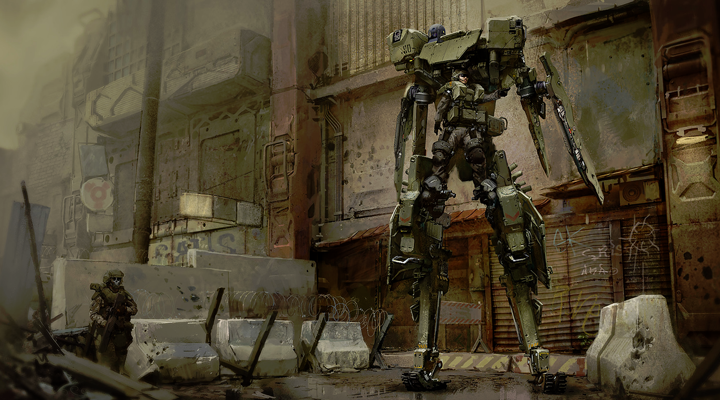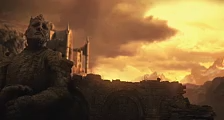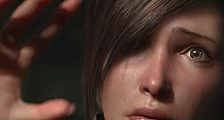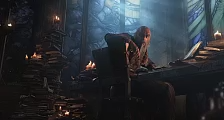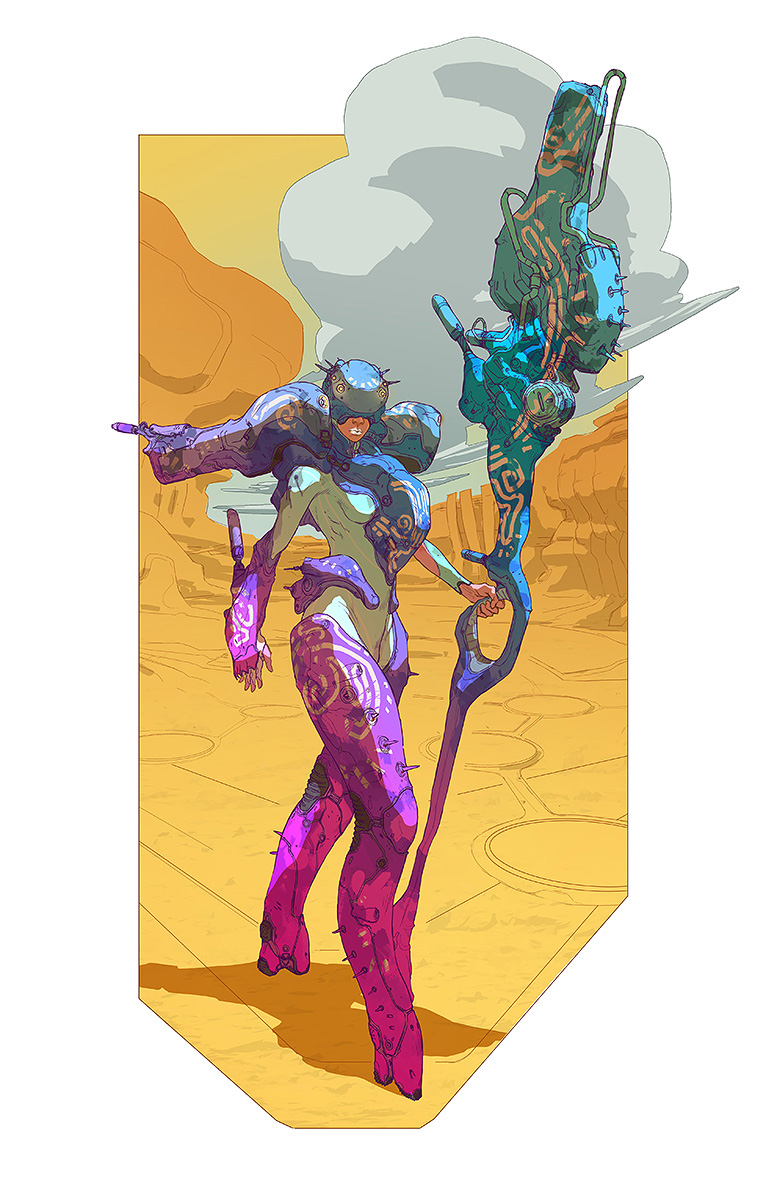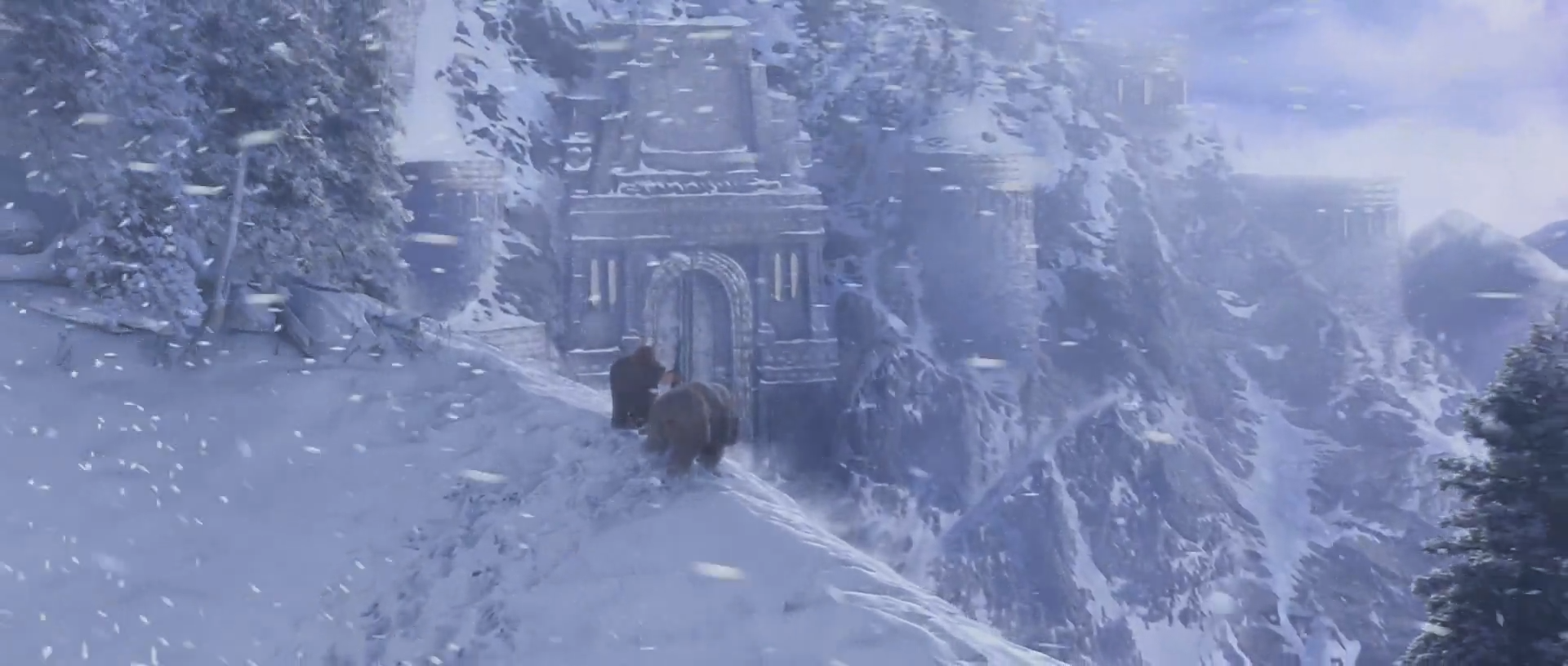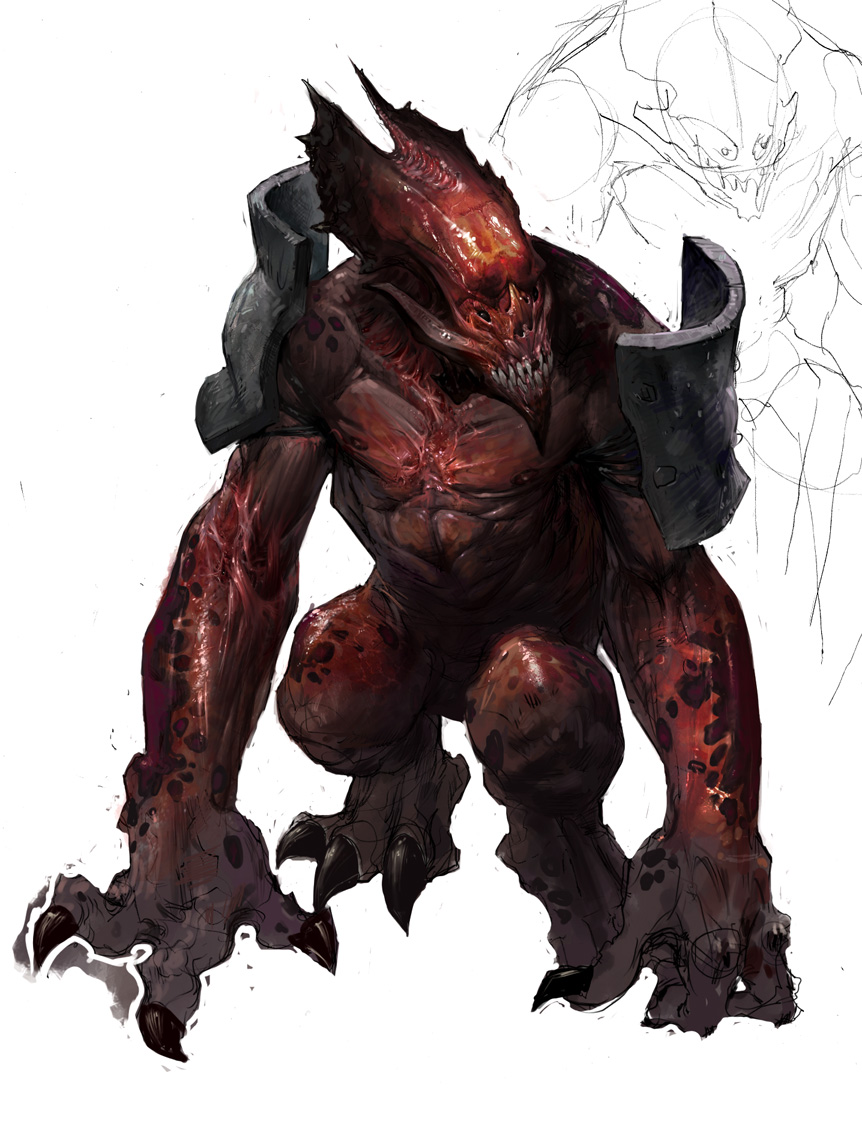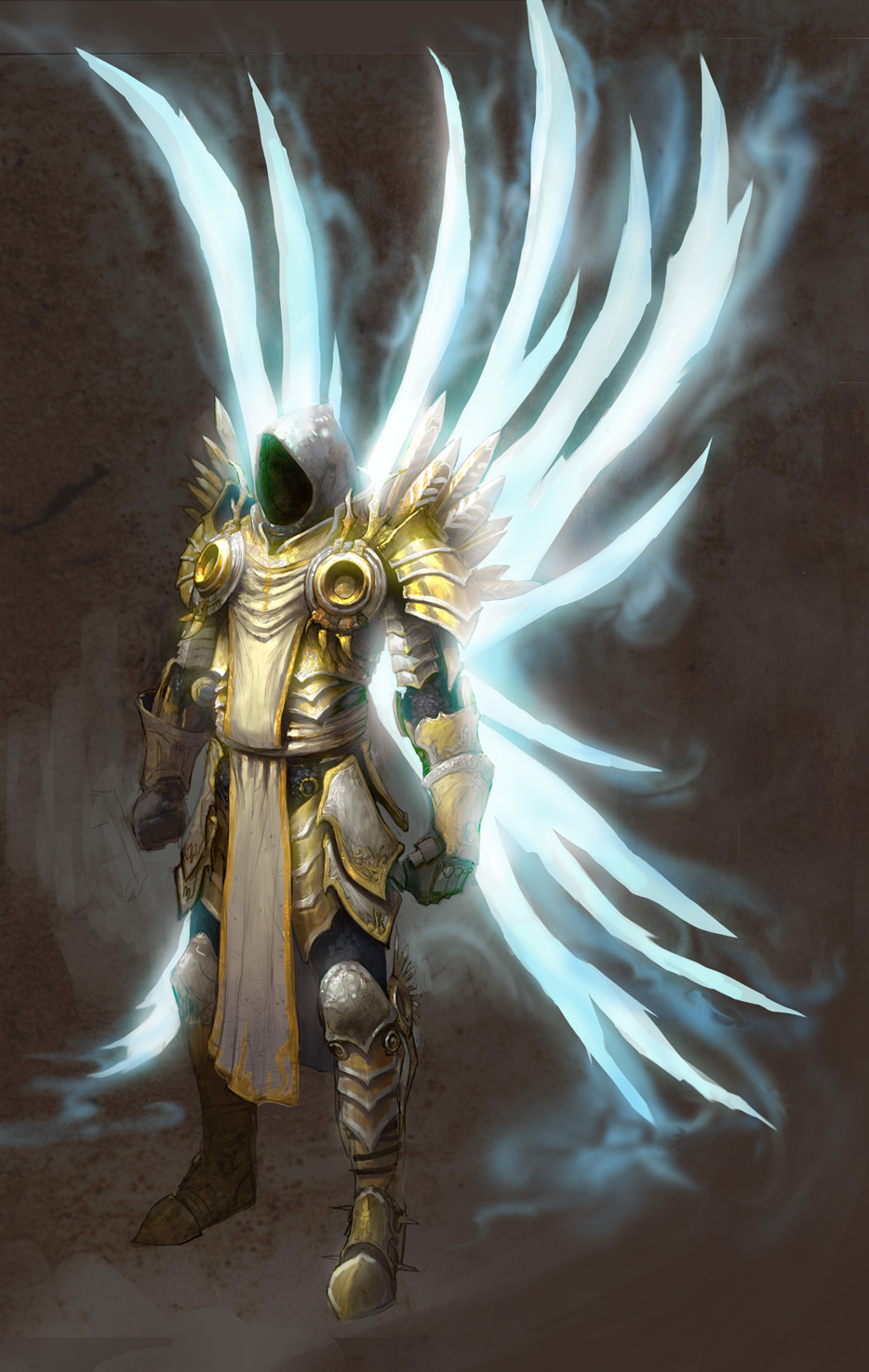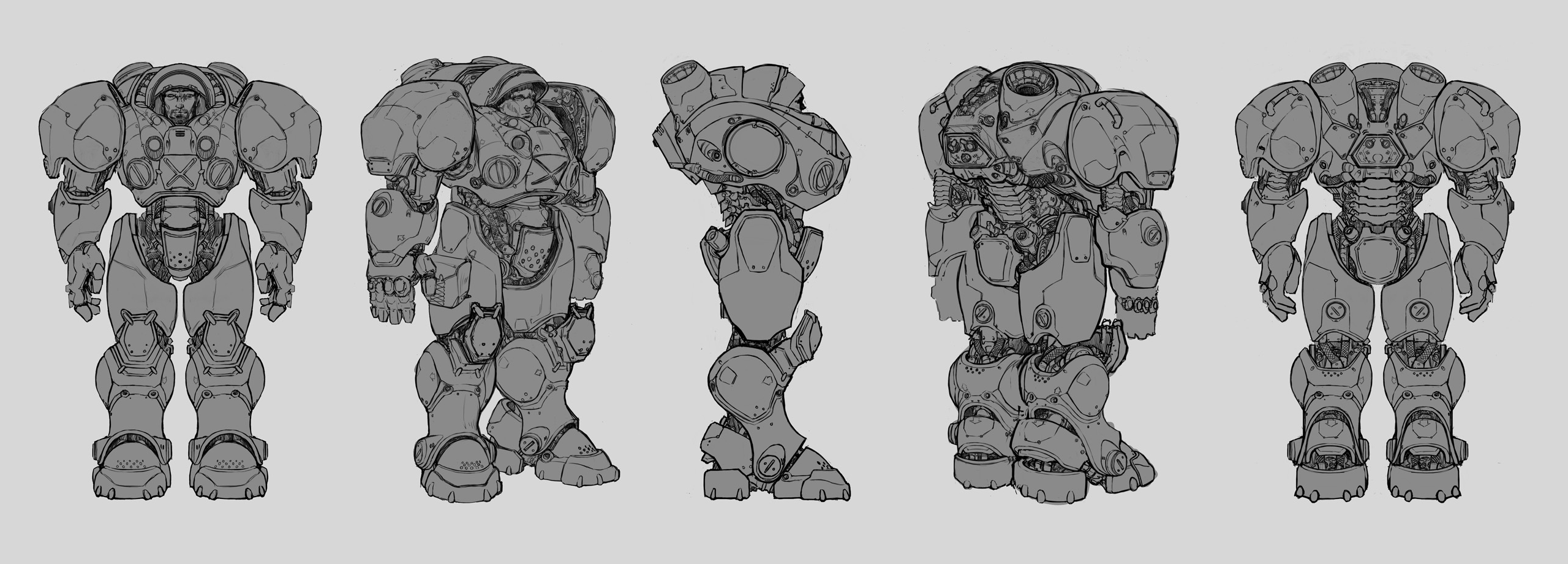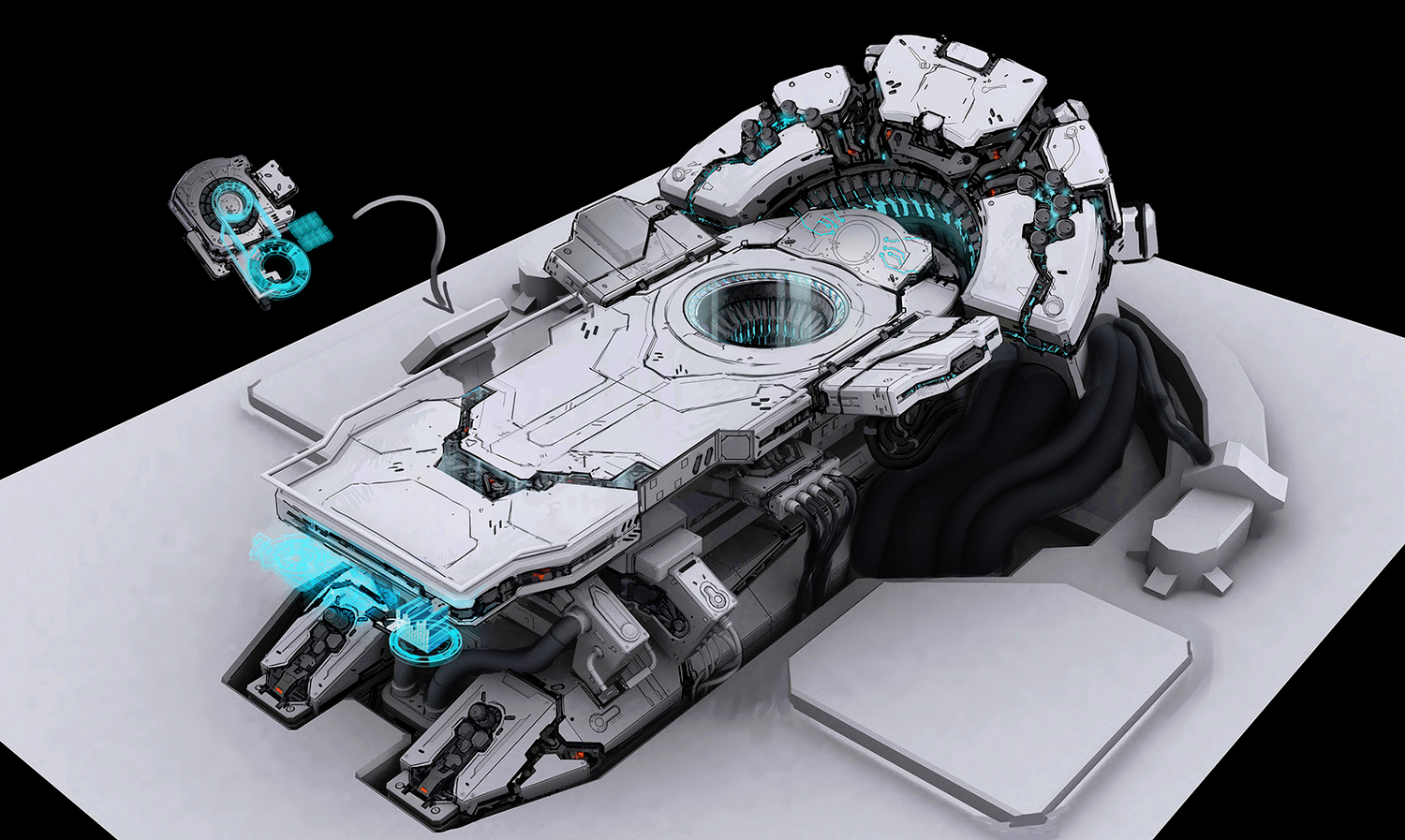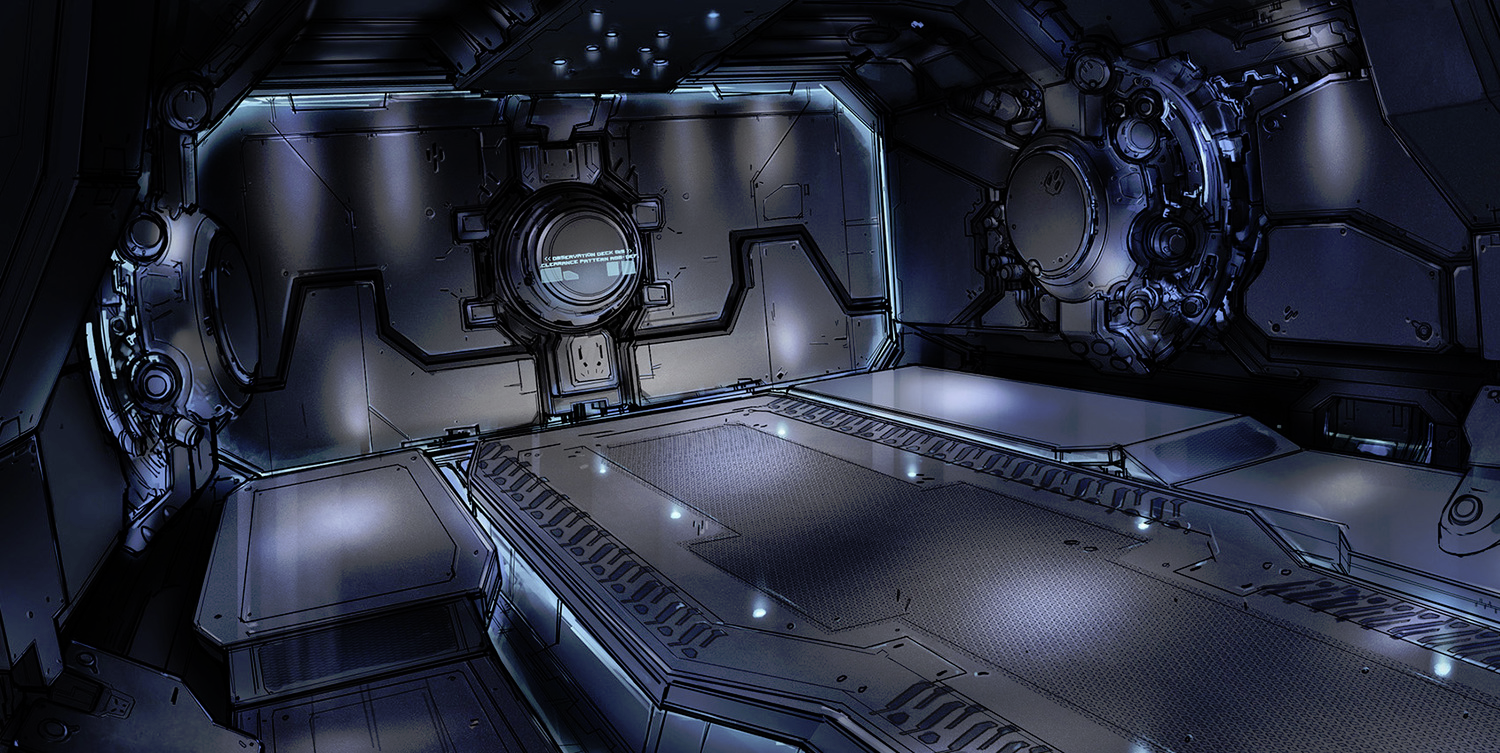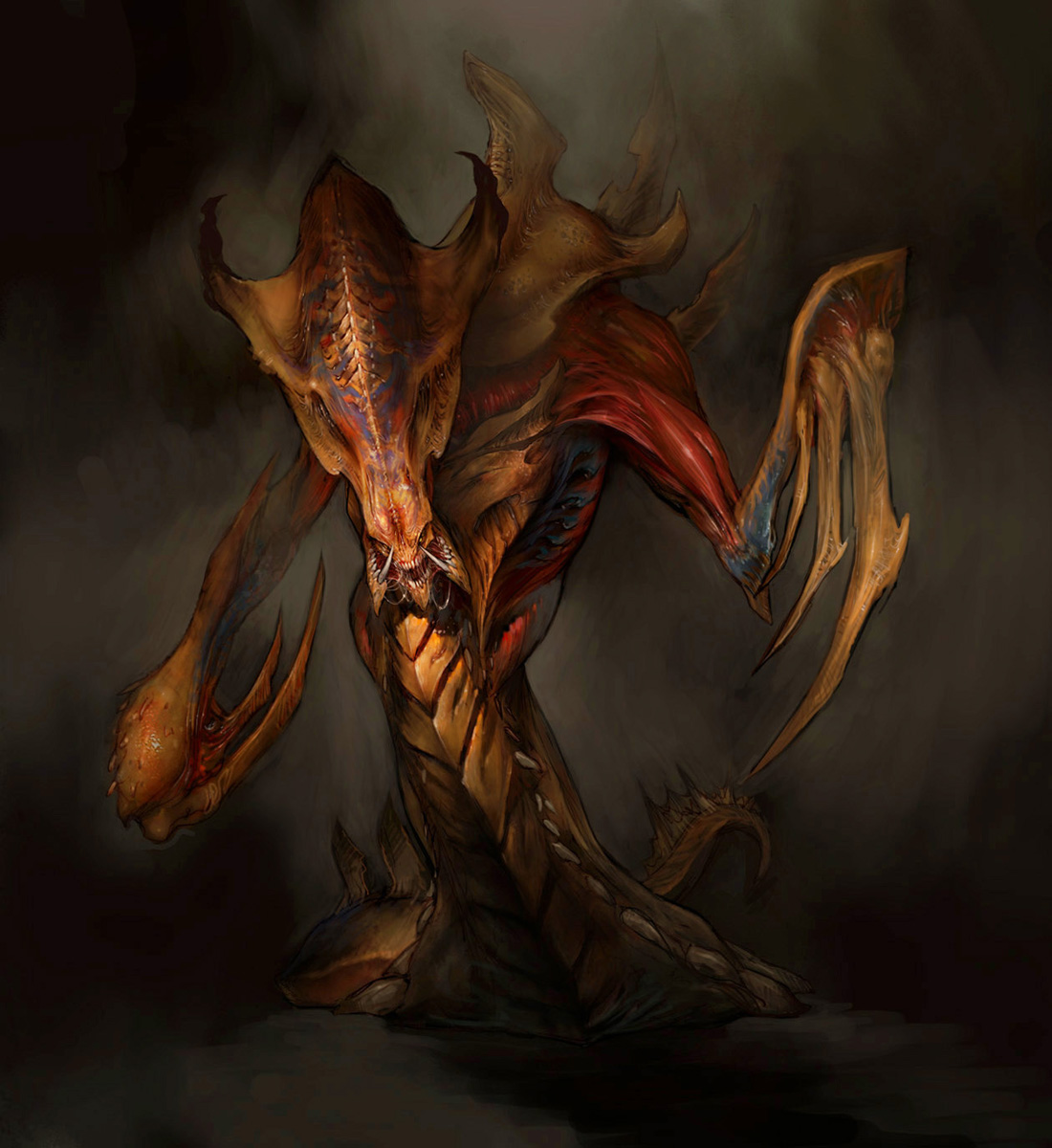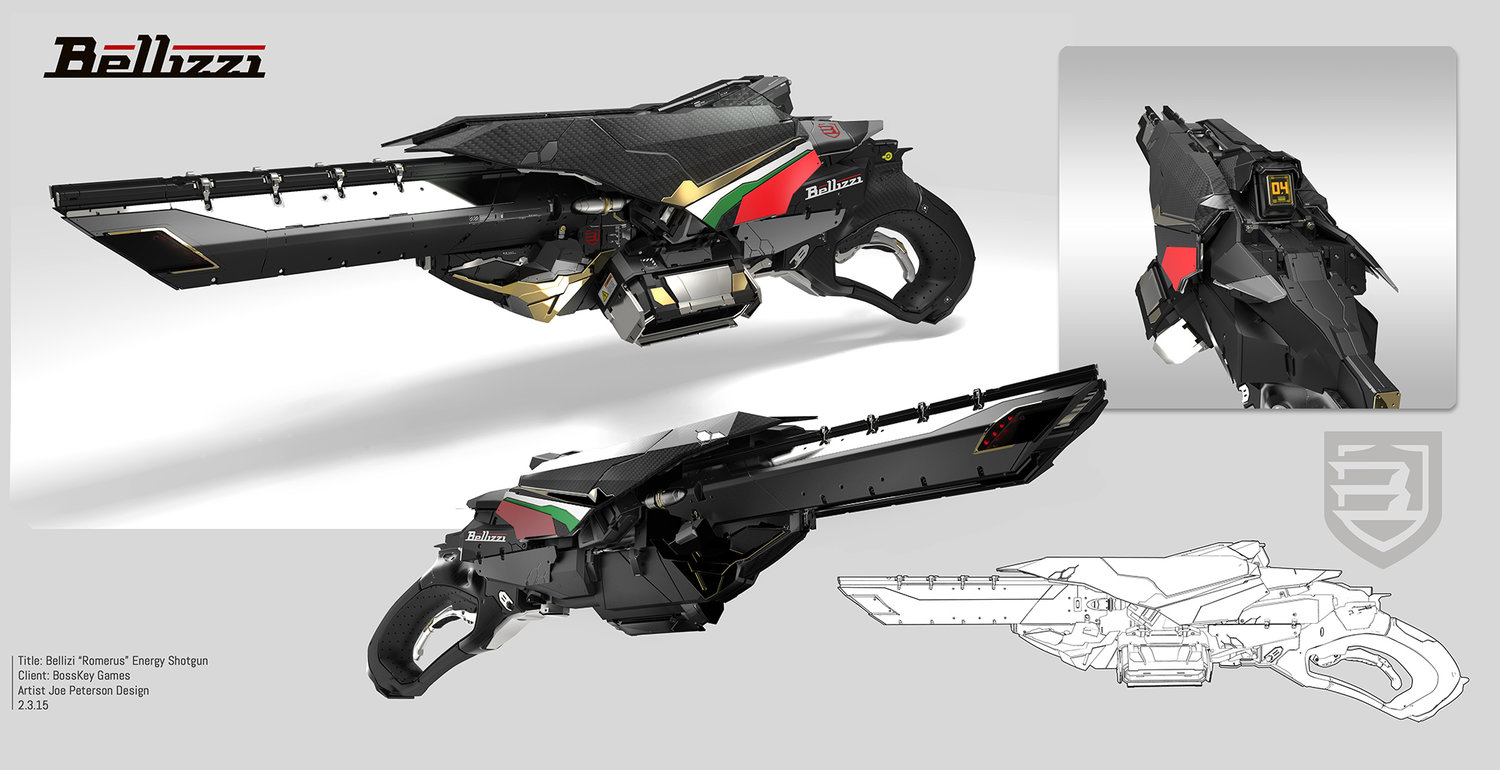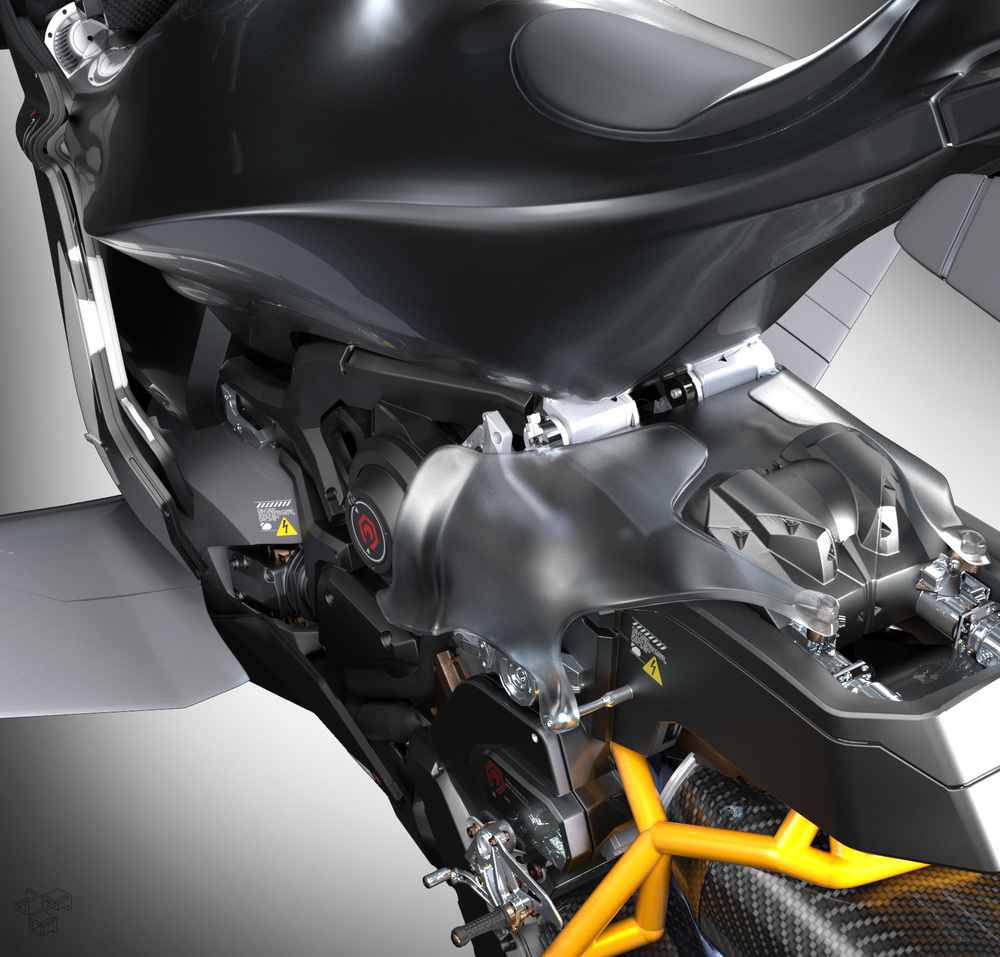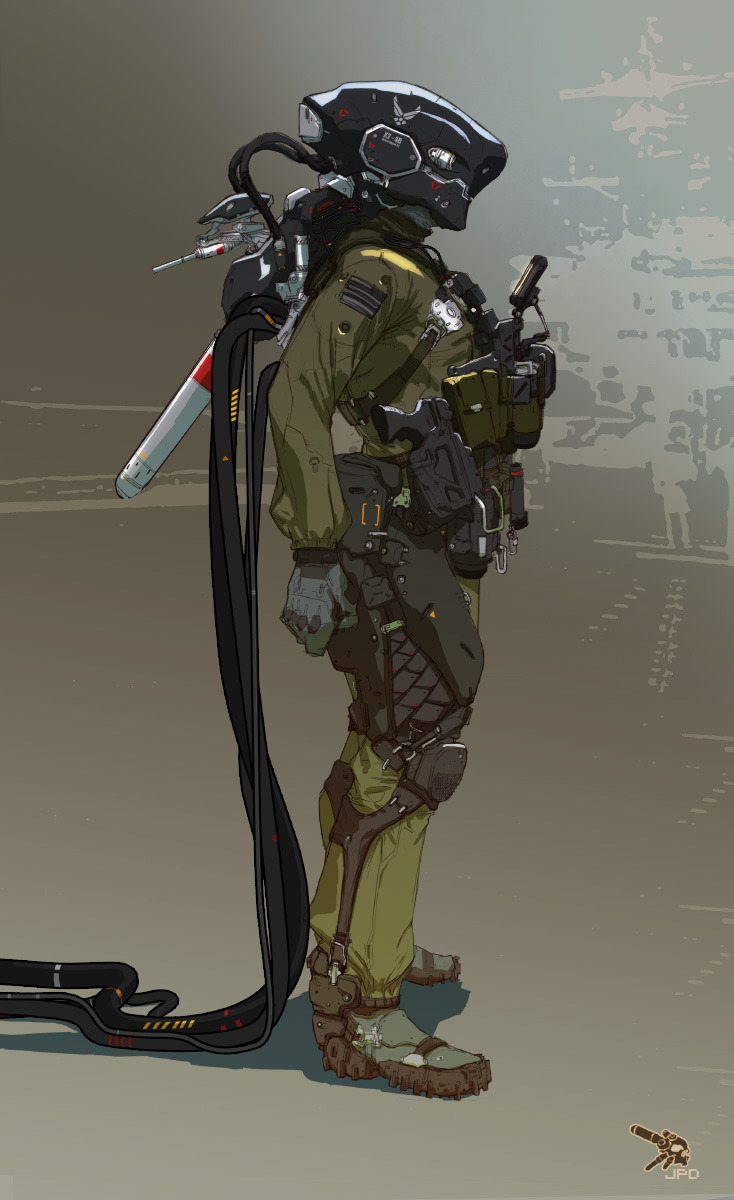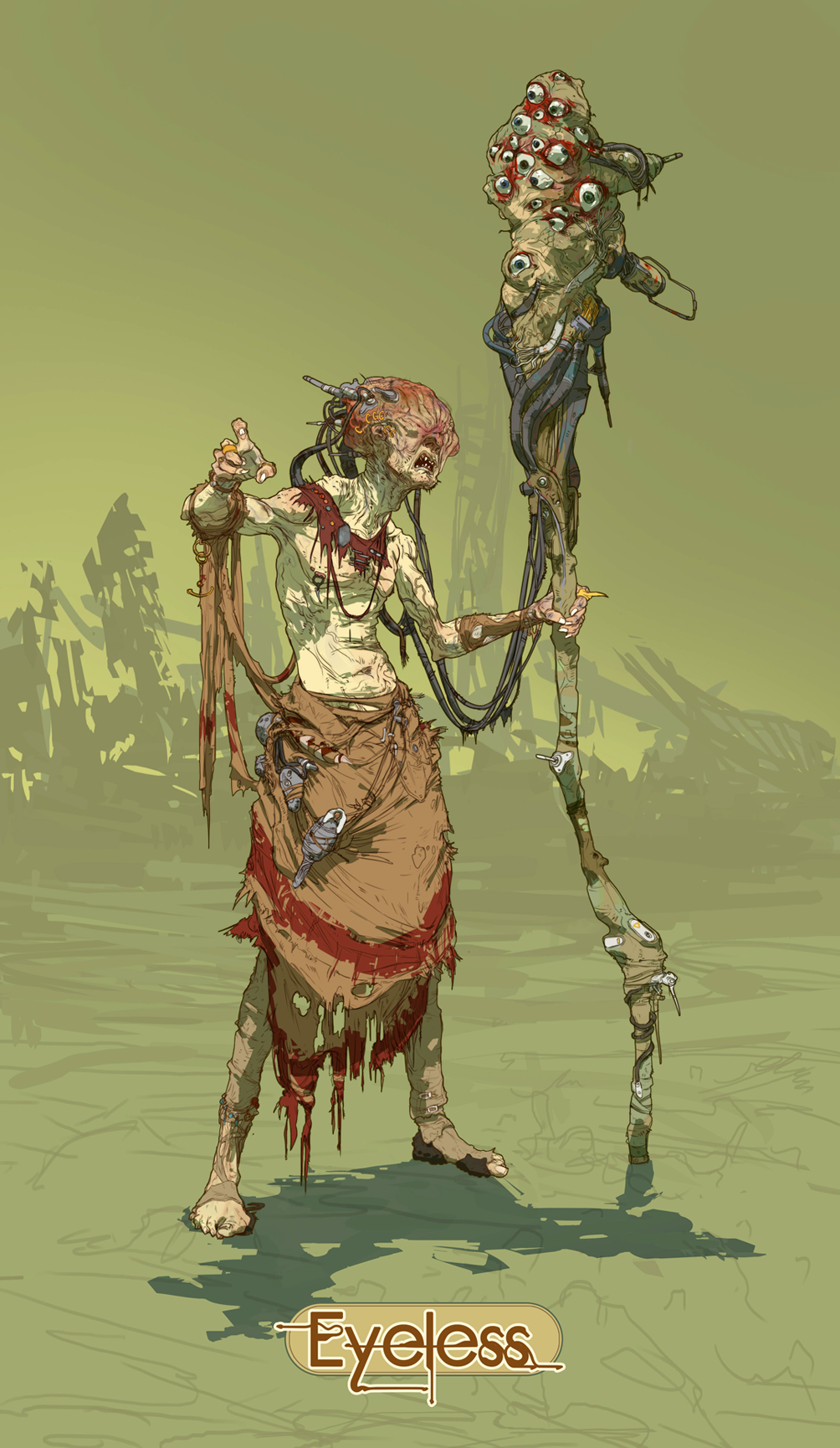Bailey:
So, did you watch a lot of movies and read comics as a kid?

Joe Peterson
Joe:
Yes, I did. Of course. I'm kind of a quintessential 80s kid and so I still get chills when I hear the He-Man intro song (for the cartoon). I was really into all the movies that came out when I was a kid like Flight of the Navigator, Dark Crystal, RoboCop, and even some of the funkier ones that not everyone remembers like Batteries Not Included or Robot Jox. So, when I was young I always had a mental catalog of all that stuff.
I didn't get into comics until middle school, but I didn't really do the standard X-Men, Superman, and Batman. I was definitely more into Appleseed and Ghost in the Shell. I guess the American stuff that I liked was mainstream, but it wasn't mainstream in the way X-Men was. I found Geof Darrow and Frank Miller's Hard Boiled, and a lot of Simon Bisley stuff like Lobo. Kind of creepier stuff too, like the Hellraiser comics really had my attention. And Heavy Metal. So, I would always go to comic book stores, and I loved them, but I wasn't there for things like Spider-Man.
Bailey:
I hear what you're saying. For all the comic stuff you were interested in, were you really into the stories or were you starting to become interested in the art, more specifically?
Joe:
Yeah, it was probably like a 60/40 ratio. When I read the comics I wanted it to be interesting, but a lot of the time it was just about the art. I read Ghost in the Shell I don't know how many times when I was in high school, and I didn't understand a word of it. It was just so thick. The politics, the subtle scheming, the technology, and all the inferences. I was just like, "Alright, well this looks really serious, but god damn I love the way Shirow draws." So, it depended on the story. I remember reading The Books of Magic (one of those Vertigo series) and just being totally floored.
Some of Joe's earlier reading.
A lot of the time it was about the art. I would have to get sucked in by the cover to start getting into something. That was one of my big disappointments about comics that I never understood. The covers were always so badass, but then you'd open it up and it wouldn't be the same as the cover. I'd just be like, "What's going on here? What are you trying to pull?" And then I would open a book like a Simon Bisley book where every panel is painted. Or I'd open up a Heavy Metal. Or there was Milo Manara, who drew all the naked women. He's a European guy and he would just draw these beautiful panels, every single square. Or open up a Geof Darrow. His whole thing is just going completely mad on every panel. And that's the kind of stuff that stuck with me. Like, "Holy shit. This guy is just insane." The drawing comes first.
Bailey:
So, you really like the line work kind of stuff.
Bailey:
As opposed to mass painting.
Joe:
Yeah, I kind of started line drawing as a kid. And it's still my native territory I guess.
Bailey:
I was less into comic books and more into comic strips, like Calvin and Hobbes. I spent a lot of my time reading those things and looking at the art and the ink work.
Joe:
Yeah, totally. I remember realizing how good the Calvin and Hobbes panels actually were. Like how beautiful that ink work actually is, and the draftsmanship is pretty fucking high up there.
Bailey:
Absolutely! Yeah, I fell in love with that stuff when I was a kid.
Bailey:
So, where were you born?
Joe:
I was born, randomly, in Costa Rica. But I'm American and there was no real reason other than the fact that my mom was kind of spontaneous and she decided to go on one last trip before I was born. I came out two weeks early.
Bailey:
Took a risk, there!
Joe:
Yeah, that was kind of my mom's style.
Bailey:
Do you have a big family?
Joe:
No, it's always been really small. My dad wasn't in the picture, so it was mostly just me and my mom. She had one sister, her identical twin, and she was kind of in my life, and not so much anymore.
Bailey:
So, is your family creative types?
Joe:
No, not really. My family was supportive, though. So, I didn't have to convince anyone. My mom was really open-minded and laid-back. She wasn't worried about me doing one thing or another. My aunt, for example, was a docent at The San Francisco Museum of Modern Art. So, she's really into it. When I went to art school, she was like, "Oh, go for it."
Bailey:
So, you had some of that surrounding you while you grew up.
Joe:
Yeah, definitely. Although, since my family is really small, I do have a godfather figure in my life. And he was always really great, supportive, and loving. And we're still close. I would always draw cyborg chicks and monsters. But even as I was getting into school, he and his partner finally confessed they were wondering when I was going to "grow out of it" of and make grown-up art. Turns out I never do, and I go on to get a nine-to-five job after school and do okay for myself. So, they were finally like, "Oh okay, this is actually the path you are on. Nevermind."
The Armored Wanderer. (A more recent piece by Joe)
Bailey:
And it turns out there are a lot of people like you who just want to make robots and cyborgs and all that stuff. [laughs]
Joe:
Yeah. And luckily the entertainment industries were such that, when I got out of school, being a concept artist was actually a real job. I got out of school right around the time when, at Pasadena ArtCenter, if people wanted to do concept art they would do industrial design and learn how to draw cars and design objects, and then they would work for entertainment companies. But now you can just straight up study game art, concept art, or entertainment design.
Bailey:
Yeah, it's very different. The space is much bigger nowadays.
Joe:
It's way bigger. Even on the indie side of things. You don't have to get a big, full-time job at some company. It's good.
Bailey:
Absolutely. Did you enjoy your time at college? Did you feel like it was worth it for you?
Joe:
Yeah, I have a funny take on that whole experience. Ultimately, yes I'm glad I did it. But I definitely felt torn about it after I finished because I ended up going to an art school that was a little more art world (fine arts oriented) where they just wanted to cultivate you as a thinker and let you find your own way. Lots of emphasis on a big architecture program, a super crazy graphic design program, and really, really heavy fine arts programs. In illustration it was more like, "Hey, yeah you can draw and paint and stuff, but do it your own way and find your own style." So, I was drawing what I was drawing in my sketchbook. Like figures and imaginary stuff. And I had a couple teachers that were kind of like, "Well, alright if that's what you want. I don't know, sure." They got it, but they didn't really know what to tell me or how to talk to me about it.
The schooling otherwise was really good and mind-opening. It was really fun going to a school like that. But it was double-sided. I still feel like my technical skills lack because of missing some foundation stuff in college, but what are you going to do?
Bailey:
Well, it was more traditional art, right? Do you mean a different kind of foundation?
Joe:
Yeah, just your classical painting and drawing stuff. Rendering and drawing from observation. I mean, I drew a ton. And I got a job with my sketches, thankfully. So, I kind of pushed myself in that direction anyway. But they did not emphasize the technical foundation there. You knew about it and you were exposed, but it wasn't like, "Hey, let's paint a perfect nude figure."
Bailey:
And I hear what you're saying about the community being a little different at the school you went to. Like when I tell people I'm an artist, I have to clarify that it's more like entertainment art. It's a different world.
Joe:
Yeah, it's in between. I think that stereotype about getting an art degree is like, "Oh, you learn how to paint your feelings and then you get into the real world and you can't do anything." And I think that's a crock. You and I both work in kind of a commercial industry. We're in between. We're not making fine art and trying to sell it in a gallery. We're artists, technically, but we're making commercial products, right?
Bailey:
[laughs] Yeah, the thing that I like about it is that it's more like we're trying to tell a story and we do whatever we have to do to do that. Whether it's a commercial, a game, or a film. It's less like art for the art's sake, and it's more for a greater whole.
Joe:
Yes, I totally agree. You're playing your part in the process.
Bailey:
Yeah. So, you said that your sketches helped you get a job. Was that Blizzard, or was it something else before that?
Joe:
That was Blizzard. When I was in school, because of the situation that I described, I was drawing a lot for myself and trying to sketch things from my imagination and draw from life.
Bailey:
To push yourself.
Joe:
Yeah, to keep my hand moving. And towards the end of school I grabbed the things that I thought were the best that I had done on my own. Of course, I threw out all my school assignments because none of them applied or they were all kind of awkward. I put up my favorite drawings that I had at that point, and then I crossed my fingers. I was actually pretty stressed out about it because I had no idea what was going to happen. I was kind of worried that I was behind the curve and wouldn't get hired.
Funny enough, Fausto De Martini saw my work and that was right around that time that the cinematics department at Blizzard had realized that they needed their own full-time concept artist. Because they had had a guy there, Ru, who went on to start Ready at Dawn a little while after. He had worked at Blizzard and he would pitch in for cinematics and do some concepts, but he was on a different team. And I think they realized, "Alright, our production is getting a little more involved." They came to the conclusion that they wanted someone full-time. And Fausto showed somebody my drawings, thankfully. One thing led to another and I ended up going down there. It was an awesome first job to have.
Bailey:
They basically reached out to you after Fausto saw your stuff online.
Joe:
Yeah pretty much. Thank god for Fausto.
Bailey:
[laughs] He's a cool guy.
Joe:
Yeah, he's the best.
Bailey:
So, what was the first cinematic you started working on while you were there?
Joe:
They were finishing up the original World of Warcraft launch cinematic. They were literally lighting the final shots and comping the final stuff in. So, I painted a couple backgrounds that were missing. So, I got my name in the credits. [laughs] But I got there after the huge effort that went into that thing. I kind of helped get it out the door and then celebrated with everyone.
Joe painted the background behind the hill and characters. From the World of Warcraft cinematic.
After that it we started on Diablo 3. This was when Blizzard North was still alive and they were working on Diablo 3 up there. I ended up designing a couple characters, but there was only like one that remained that I worked on. Everything I did kind of got scrapped because they reset the project pretty hard once or twice. So, by the time those cinematics actually came out, it was a totally different story. But it was fun to work on.
An unused demon concept for Diablo 3.
Bailey:
Which one survived the chop block?
Joe:
Tyrael. He's kind of the main angel character. He has the golden armor. I designed him and, like a couple other things in cinematics, I can't say, "Oh yeah, I designed Tyrael for Diablo." No way, because he had been in the world. They had him already and had the artwork from Diablo 2 and the cinematics. So, what I did, which I would go on to do a couple more times, was take the old artwork, watch the cinematics, understand the story, understand who the character is, and look at the old school concepts from like 1990-whatever drawings. Just soak it in and then figure out how to up-rez and maybe update the design a bit, so that the spirit of it is definitely still there. It's very recognizable, but my goal was to make it feel like, "Okay, now we're actually seeing this character as if they really existed and you're right there in front of them."
So, I would add things or I would use the existing shapes, but really embellish them. If there was an armor plate, I would double plate it, work in some filigree, figure out how all the details flowed, and really get the curves of the outline down so that you really enjoy that form now that we're gonna model it up in high-rez for the cinematic. So, that was my approach. But anyway, Tyrael is the guy. I will say that I did give him his face, which was cool.
Tyrael concept for Diablo 3.
Bailey:
You mean you designed his facial structure?
Joe:
Yeah, I did the first one and then, after I left Blizzard [laughs], they redid it. Fausto, I think, went back and changed it somehow. Things get adjusted a lot.
Bailey:
So, for that kind of work, was it mostly just 2D stuff or were you doing 3D block-outs and then painting over it?
Joe:
Um, no I was doing almost all 2D. The only time I did 3D block-outs back then was when I needed to figure out some of the animation stuff on Building a Better Marine. Just because there were limitations and things needed to fit in certain places. So, I mocked-up one or two things in 3D and did some animation to just make sure it worked, and then drew the shapes. But yeah, it was all mostly starting in pencil and then going forward. I was still scanning drawings back then.
Bailey:
Oh nice. You know, I actually still feel pretty comfortable with pencil, even more than a tablet.
Joe:
Yeah. Okay, I love hearing that because I actually just had a resurgence of wanting to just keep things simple and keep it handmade. So, I totally understand nothing really beats it. Something weird happens in my brain. Even though I'm usually just drawing on an 8.5x11 piece of paper, I just feel more confident or more free or...I don't know, man. There's just something about the texture of the pencil and the paper. Is that how you feel about it?
Bailey:
I think so. I've been trying to figure out what it is. It might just be there is absolutely no lag.
Bailey:
My ideal is I want the tablet to feel exactly like a pencil, except I have undo.
Bailey:
And layers, yeah, of course.
Bailey:
Right, that too. [laughs]
Joe:
And blend and opacity. [laughs]
Bailey:
And masks. Yeah, all of that.
Bailey:
That's cool to hear you say too. So, for the Building a Better Marine cinematic, what were you concepting on that? Were you doing the armor or the environments?
Joe:
All of the above, really. All the mechanical stuff. I started on the marine because that was the main focus. We iterated on that a lot. Fausto was doing sketches, bringing them in, and bouncing them off Nick (our director). We'd all talk about it and try different things. Just beat on it, you know? Just over and over and over. I ended up doing a drawing, almost like a hand-drawn turntable. I did front, back, side, and 3/4 front and back. And Nick, at some point, took the drawings and made a little movie out of them. It looked like he was spinning. The perspective was all wonky and everything, but we wanted to figure everything out, so I just wanted to make sure to draw it from every angle.
Different angles of the marine's armor in the opening cinematic for StarCraft 2: Wings of Liberty.
Turntable loop of the marine drawings.
Bailey:
How did you feel the stuff you made turned out?
Joe:
I was happy with them. I was always still on edge and trying to prove my mettle. I still felt like I was the beginner there, and I was. The more I did, the better I felt about it. But I did feel good about the marine because I just felt like we had really pummeled it. We iterated so much, and when I looked at it, I was happy with it and thought, "This is what we should be doing as we're going forward with the IPs and trying to make them as real as we can in the cinematics." I felt like I was doing my part for whatever it was worth in that process.
Bailey:
In terms of the realism, starting with StarCraft 2, I felt the believability really started to increase. Especially once you guys got into the Diablo 3 cinematics.
Joe:
Totally. There were a couple things that they did really well. They got Leah's skin down really well. Those environments were just off the hook. They really worked hard on them and really brought the quality level up. That was good.
I think Better Marine did help set that tone, because you're zoomed in on everything the whole time, right? So, you're seeing all the mechanical grit and nuts and bolts the entire time. I think that's one of the reasons it kind of popped out a little bit as a whole piece.
Bailey:
Definitely. I really liked watching that when I first saw it.
The opening cinematic for StarCraft 2: Wings of Liberty. Also referred to as Building a Better Marine.
Bailey:
I was like, "What is this? Holy shit. I like mechanical stuff!" I watched it on repeat for a while.
Joe:
Did you? Awesome. I did all the hands, the room, the door, and the podium and all that. But a lot of that stuff was just line art. If it weren't for the rest of the team modeling the hell out of it and everything.
Bailey:
Yeah, it's always a collaborative effort. These things take teams of people to make.
Joe:
Of course. Yeah, it was weird for me watching it because I left Blizzard before they finished it. I kind of got squirrelly. I got antsy. And I really didn't like living in Orange County. Some other guys left and started Red 5 Studios. I was feeling kind of adventurous, and to be frank, I knew that I was starting to pick up on the fact that as much as I loved Blizzard cinematics and as awesome as the team was and how cool and great a job it was, there was a really good chance that my being able to invent something new was pretty slim. I might be doing a lot of things like taking characters and updating, up-rezing them, and things like that. Not to sound like, "Oh, I'm above that," or anything, because I love doing it. But when these guys left and started Red 5 Studios, they were talking about doing an open world, sci-fi, shooter MMO. And I'm just like, "Uh, fuck yeah. I want to work on that." It was all so open.
It actually turned out to be kind of a nightmare, and it was a crazy experience going and working there, but we got to make an IP from scratch. The game that they made did not come out very good. I could go on about that, but that's a totally different subject. But what we wanted to do and what we were starting to do, I actually felt really good about. It was really cool. I think if we could have seen it through and polished the art direction to where it could have been, it might have made the statement we wanted to make. I feel like I did everything I could to contribute to that. That part I feel good about.
So, I left Blizzard before they finished Better Marine, and when it came out, I was at Red 5. And we were in a super startup situation. It was like fifteen or twenty of us. And a lot of people are watching the cinematic and tripping out like, "Oh my god." And I'm sitting there watching it like, "Wow, what did I walk away from?" [laughs] It was kind of weird, but it was what it was.
Bailey:
You were saying before about the stuff you were doing at Red 5. Was it the art style that wasn't where you wanted it to go? What was it about it?
Joe:
It was a little bit of everything. The whole thing was kind of a mess because there wasn't one person responsible for the story and for the overall design. We did have an art director, Bill Petras, who was the original art director for World of Warcraft and is now the art director on Overwatch. That was another reason I left, to work with him. So, it's kind of hard to answer the question because while we there, I felt happy about what we were doing. It was really hard and it was really weird to erect something from the ground up and have it be unique.
Bailey:
But eventually you went back to Blizzard and you started working on the in-game cinematics, is that right?
Bailey:
So, how was that for you as opposed to working on the pre-rendered stuff?
Joe:
I don't mind working at lower rezes or having to manage resources. It was good. The most limiting part of that was they were developing the game at the same time. They were developing the story as it relates to design and vice versa. And that's completely logical, because that's how it's done. Games come together in all kinds of different ways. The hard part was trying to develop the best cinematics we could while things were either moving around, or they weren't concrete, or whatnot. But, with that said, I got to sit in with the director for the cinematics, Ben Dai. And people like Chris Metzen, Samwise Didier, and Brian Kindregan (who was the writer on that team at the time). I got to watch the story unfold. I felt really lucky to be in that position. It was very cool getting to be a fly on the wall and speak up and chime in when I thought it appropriate.
A design of Kerrigan's bed for the StarCraft 2: Heart of the Swarm in-game cinematics.
It's a machine with a lot of moving parts, so it's like, "Hey, I think this should happen here and I think you should totally change the final cinematic for the Heart of the Swarm expansion." [laughs] It's kind of like, "Well, why even bother. This machine's rolling, I may as well just grab hold and ride it to where it's going as opposed to trying to be too disruptive." Balancing those things was a big part of it, and there are really, really cool sides to that. And growing pain learning experiences as well. But it was really cool. It was fun to do. And I love StarCraft, so it was great working on that again.
A design for the StarCraft 2: Heart of the Swarm in-game cinematics.
Bailey:
What was ultimately the driving force behind deciding to leave Blizzard again to pursue your own work as a freelancer?
Joe:
It was a lot of things. It was kind of a cocktail of things. Ultimately, I was still in Orange County and that's not the place for me. My fiancé, then girlfriend, was living with me at that point too, and neither of us felt at home there and like it made any sense. The benefits of working at Blizzard weren't outweighing living somewhere that I didn't want to be anymore. And, personally, I wasn't sure what to look forward to in the future at Blizzard because I knew what Overwatch was becoming and I felt like I had kind of done StarCraft and they were going to make the third expansion for StarCraft. That was going to be it. I wasn't sure what was going to happen to the in-game team. I went and worked on the Titan team, the team that eventually became Overwatch, and that was awesome and I learned a lot.
However, there were creative things and logistical things with the team that made it so that I didn't know what was going to happen and I didn't know how or when I'd be able to have an impact. And so, all of a sudden I'm looking around. And as fun and as awesome of place Blizzard is to work, I realized, "I hate living here, and the only thing outside outside of my home life is work. And now all of a sudden I'm a lot less excited about work." I really had to think about it because I didn't want to take Blizard for granted. They were gracious enough to have me back. I was really good friends with some people there. I fit in there, and I did some really cool stuff with some people there. It was kind of like, "Aw, geez. How do I weigh these feelings?" And ultimately I had to take a step back and just look at the big picture and think, "I want to be pushed in different ways. I think the work here is only going to look a certain way, and there are only certain things that are going to be happening in the future here." So, I backed out and started making my way as a freelance artist since then.
Bailey:
I think that's good. You were listening to yourself and carefully evaluating what it was that you needed in relation to the opportunities you had at Blizzard and the friends you had. I wish that more artists and creatives of all types would listen to themselves more, because it can affect the work if you start losing the passion, or you start getting burned out, or frustrated.
Joe:
I'm happy to hear you say that because I feel a little less crazy. Because it's hard to weigh that stuff. It's like, "Okay, I'm totally clear that this is an awesome situation, but I still have reservations and I'm still being pulled in different ways, and so how do I keep all that stuff in mind and move forward with it? How do I weigh all that stuff?" I'm glad I did it. It was good. I think I've been pushed in ways that might not have happened had I stayed there, you know?
A hydralisk concept for StarCraft 2.
Bailey:
Oh yeah. I can relate to that. I mean, my past is different from yours, certainly, but when I decided to go freelance a couple years ago, I really had to weigh all the positives and negatives of that. I was not as happy as I wanted to be at the company I was at, so I decided to give freelancing a shot. And I have no regrets about it.
Joe:
Nice. Has it been going well?
Bailey:
It's been great. I've learned so much. I've learned so many different kinds of things that I never thought I would.
Bailey:
Especially on the business side of things. It's just been eye-opening.
Bailey:
What kind of stuff have you been doing as a freelancer?
Joe:
Lately I have mostly been working with Riot on some unannounced stuff. It's been really cool. They're a great company to work with. They're very employee-centric. And I got do to a little bit of stuff on Doom. I did a tiny bit of environment stuff. I'm not even sure it ended up in the game, but it was cool to be able to work on it. It's one of those things, right? An opportunity that I would have never expected. And I loved the art of Doom 3. So, getting to do stuff for the next Doom was great.
I did a little bit of work for Boss Key. One of its founders is Cliff Bleszinski, the Gears of War guy. He opened a startup and they're working on a multiplayer shooter. I did a couple designs for them, and that was really fun.
I recently did some movie work. I actually got to go down and work with Fausto and a bunch of other people on some development pitch stuff. Again, another one of those opportunities that wouldn't have come along had I had a full-time job. It was a crazy learning experience going to LA, meeting people I wouldn't have met otherwise, and trying to do my best. So, yeah, it's been kind of all over the place. It's been varied.
A gun concept for LawBreakers.
Bailey:
Do you like that variation?
Joe:
Yeah, I do. I do like working on single projects because you can get to know it, dig down, chisel out problems, and feel a little more connected to it. But it's nice to break it up, so that you're just thinking about things differently and having to have a fresh outlook really often.
Bailey:
Yeah, there are pros and cons to both.
Bailey:
So, when you're in the heat of a project, what's your process look like? What's a typical day?
Joe:
When I'm starting something or when I'm right in the middle?
Bailey:
Right in the middle.
Joe:
Well, it's pretty normal, really. I work at home, so I'll get up and hang out with my fiancé in the morning. And then come upstairs to work and a lot of times I'll just have what I was working on still up on my screen with all my reference and stuff. Usually it takes me a little bit to either go over notes or stare at what I was doing and get back into the mode a little bit. What I was thinking and where I was. It's pretty straightforward stuff. I sit here and bang it out. I'm always looking for reference and trying to understand things. On one project I was doing some designs that had a lot of thrown-together machinery, but it still needed to be believable. So, I was asking someone who knows about motorcycles, "What's this called, and what's this do?" Someone wanted some hydraulics in a certain place or a joint. Even though it was thrown-together, they wanted a joint in a certain place. So, I really have to stop and look. I'll take breaks and grab reference and really stare at things until I understand them. Whether it's a certain kind of weapon or looking at how certain machinery works. I know that's obvious. Every concept artist in the world does that, but I like to take a little time and see if I can really internalize how a certain thing will work.
When I got into guns—I had never shot a gun, and I really need to—but I would get all kinds of reference and would sit there and stare. I would watch videos of people reloading them and talking about them. I wanted to really understand it. "Why are these things here? What's important?" Like, "Oh, the complicated part is ejecting the shell after the explosion and that's why this is here. Oh, it's really just a simple barrel." So, I'll look for reference, and do all that, but it's really just me working at home with my cat and banging stuff out. And waiting for feedback in the email. Pretty standard stuff, I don't do any magical rituals or anything.
Bailey:
[laughs] I know. I just like to hear how different people work, and how they block out their time because it can be interesting. I'm always trying to find ways to improve my own workflow.
Joe:
I could be a lot more disciplined about using chunks of time and setting goals. I have friends who that works really well for. I sit down and I make sure that I'm putting a certain amount of time into things, but also sometimes things get derailed or they go a different direction.
Bailey:
Yeah, you gotta be flexible.
Joe:
Yeah, so I kind of just focus on the task at hand and just break things down into lots of mini-goals. I'm like, "Okay, this is all I need to worry about right now." Because if I think about the whole project or an entire section of it, I can't get anywhere. So, I'm just like, "Look, I'm just gonna figure out this one little problem right now, I'm going to give someone three or four choices so we can talk about it, and that's all I need to worry about." It helps me because I wander a lot. My head wanders. It helps me stay on task, so that even if I'm working on a huge project and there are all these factors to keep in mind whether it's artistic, logistic, or technical. I gotta let all that stuff go because I'll totally get in my own way. So, I like the focused goal approach.
Bailey:
I like that. I do something a little similar where I set my tasks for the next day the night before.
Bailey:
So, that way when I wake up in the morning, I can just look at what I have to do and I'm not thinking about, "Oh, do I need to do this or this?" I can just focus on the work, so that helps.
Joe:
Yeah. I haven't done that yet and I've heard a lot about day-before stuff.
Bailey:
I think it's about just finding what works for you. I heard an interview with Vitaly Bulgarov about how he really segments up his time into even fifteen minute chunks. It's awesome that it works for him, but for me that stresses me out too much.
Bailey:
[laughs] So, I just have to do something else.
Joe:
Yeah. Vitaly is actually a good friend of mine. I think there's something there because he is one of the most productive people that I know on planet Earth. I think there's definitely something to pick up from it, but I agree with you. I'm kind of the same way. I'm like, "How do you stay on-task if it's only fifteen minutes?" But I don't think he says, "Oh, I gonna figure out the main design of this character in fifteen minutes." I think he just does things like, "Okay, I'm gonna do this tiny task in fifteen or thirty minutes, and if it's not done I'm moving on." Don't quote me on that, it might be a little different. It might just be my interpretation, but I do think that might be part of it or at least that's how I'm understanding it.
There is the idea of don't worry about it, don't stress yourself out. Just move on at the end of fifteen minutes, and that'll put what you're doing way into perspective. Like, "Oh, I didn't get anywhere on that," or, "Okay, fine. I'll need to come back to it," or, "Oh wow, look. I actually accomplished a lot," or, "Oh, gee! This is all I really had to do for that. Look, I'm actually done with that part, so moving on." So, whatever it might me. Like blocking out just a shape or whatever.
Bailey:
I think you're right. I think a lot of people want things to be really good, but there is also value in something being good enough.
Bailey:
Because as much as I want everything to be great, it's not gonna be. Some things need to be great, and other things can just be supporting that.
Joe:
Yes. Yes. Funny enough, that's one of the things that both Vitaly and Fausto helped shine some light on for me. When they started actually doing concept work, they're doing it in 3D. And everyone looks at what they do and says, "How the hell do you do that? It's amazing. I don't understand. How do you model that fast?" And knowing how to play that instrument, and knowing where and how to cut corners during the design process, is definitely a huge part of that. And so, they are really great at knowing what the important parts are and what parts are not important. I think that is a huge skill unto itself. And I'm still trying to crack that nut. I'm still just a baby when it comes to a lot of that logistical stuff and trying to really break that process down. I'm kind of a more intuitive, free-flowy guy. And that really works to my benefit sometimes when I'm trying to come up with a unique design or a cool solution, but then it also bites me in the ass sometimes. I can be a space cadet when I really shouldn't be. [laughs]
Bailey:
[laughs] So, do you like working on the details of a piece, or more of the overall, bigger picture design?
Joe:
I like the overall design. Whenever there is an opportunity to try to do something unique, that's what I enjoy the most. Cleanup is not always my favorite. It's kind of like I'm just filling in the blanks and tightening things up. As opposed to trying to come up with a totally new idea, you know?
Bailey:
You like the front side of a project rather than the end.
Joe:
Yeah, I mean, I love seeing things come together and bringing stuff home, but I definitely love the conceptual part. Designing and coming up with ideas and how to approach things. Unfortunately you don't always get to be a part of that process, but it's still really fun anyway.
Bailey:
So, looking back in your past, were there any projects or pieces that come to mind that were particularly challenging to get the way that you wanted it to be?
Joe:
Aside from every single one I've worked on?
Bailey:
[laughs] Yeah, besides that.
Joe:
More than any, it's probably my personal project that I'm working on now. I've kind of mentioned it here and there a little bit. I’ve been trying to balance out everything that's in my head and have it communicate what I think I'm going after. And learning about story writing and not just drawing everything. Yeah, it's definitely the most challenging thing because I'm on the hunt for what I want it to be and I'm trying to create it at the same time. It's this fractally complex problem where I'm never quite sure when I'm done figuring something out or if I'm only just getting started on something.
Zeta Core. From Joe's personal project.
I have a goal in mind and I know where I'm headed, but at the same time I want to be open to learning. Like, am I going to discover something that could make this better or change it somehow? Or am I going to learn something about stories where something I thought was important isn't really important, and it's something over here instead? So, I try to stay open and creative, but I also want to make decisions, move forward, and make the calls. It's fucking hard, honestly.
Bailey:
So, just to be a little more specific, are you talking about the worldbuilding or the story side?
Joe:
It's all of the above. It's worldbuilding, it's storytelling, and it's also finding a particular feel. Drilling down on the tone is a part of that. I guess you can chalk that under worldbuilding, but I see it as literally how you draw the look of things or create the feeling. That's a big part of it for me too because it goes hand in hand with what I'm trying to create. How it feels is a huge part of it.
Bailey:
It sounds like something that has a pretty large scope.
Joe:
Yeah, yes it does. It's got a large scope and I'm trying to solve a bunch of problems, but I'm happy to work on small chunks of it or show smaller pieces of it at a time. I'm not waiting to write this giant opus of a story and release huge volumes without ever saying anything about it. That's not my goal. It's more like I'm trying to get a bunch of things nailed down so that I know what's going on. So the work that I create and release for it is all under the same umbrella, and I'm clear about what's going on.
Bailey:
Do you have a plan for how you want to release some of it?
Joe:
Nothing concrete, but I think what I want to do is once I have the story 80-90 percent locked down, I'll be creating more art for it. I'll slowly start sharing that art. It's more a matter of wanting to get the overall framework down and the story down so that what I do release is all cohesive and it's there for a reason. I do want to also share a lot of the worldbuilding, sketches, and different things that I've come up with. I do want to release all kinds of designs that I've done and will do going forward. There's a big story element and there are also just the designs and the worldbuilding that I have so much fun doing. My plan right now is to release illustrations of important story beats and go from there.
Bailey:
Cool, well I'm interested in seeing more of it.
Joe:
Cool, thanks. Glad to hear.
Eyeless. From Joe's personal project.
Bailey:
So, I've got a hypothetical question for you. If you could go back in time to the beginning of your career, when you're just starting out as an artist, what would you tell yourself?
Joe:
Don't wait to do anything that sounds like a good idea. Push yourself a little bit harder so that your artwork can take you wherever you want to go so you have the choices you want to have. That's what I would say.
Bailey:
You're talking about just having a strong collection of work that will enable the opportunities?
Joe:
Yeah, I think so. Whether that's working for someone else, or being able to do my own thing, or whatever it might be. Do whatever I can to not feel I'm limited. I love what I do and I enjoy my work, but just open up all the possibilities.
Bailey:
Was there was a moment in your life where you felt like you were limited in that way?
Joe:
Oh yeah, definitely. I'm still not happy with my portfolio and compared to the things in my head, it's not even a whiff of the things that I think about, that I see, or that I imagine are possible. So, I wonder if I'd be in a totally different position that I'm in now, or in a different industry. Who knows? I don't know.
Bailey:
But you like a lot of the mechanical and character design stuff that you've been working on, right?
Joe:
Yeah, for sure. I love it, no doubt. It's kind of funny to say, "Who knows where I'd be?" But I love this shit, so maybe I'm overthinking things. Still, I think it's good to push yourself and just have no discrepancy between your intuition, what you want to be doing, and what you're actually doing.
Bailey:
Yeah, definitely. And I do think that life never goes exactly the way you expect it to. Sometimes for the worse and sometimes for the better. It's kind of fun riding that wave and seeing where things are going to go. I try to push it as much as I can, but I didn't expect to be where I am, and I'm sure other people are like that too.
Joe:
Yeah, definitely. When I was in college, I was studying art and I knew I wanted to do concepts and designs. I was so worked up about making it and making it possible that I used to tell myself, "Oh man, if I can just earn a standard living and just get by making art only, I win at life. That's victory right there." Funny enough, you turn thirty or you get stressed out or you have a frustrating startup company experience, it's really easy to forget that those more simple, inspired, and innocent goals. Actually, I've been reminding myself lately, "Look, whether or not this thing over here is funky, or I'm not happy about this or that, look at the overall picture. I'm opening up Photoshop and drawing everyday for a living. So, what the fuck, right?" [laughs]
Bailey:
[laughs] You get to draw pretty pictures and get paid.
Joe:
Exactly. And I have time to do my own sketches. What else am I really shooting for here?
Bailey:
Yeah, I do a similar thing. I say, "Well, I'm not digging ditches."
Joe:
Seriously, man. I'm not writing corporate tax software, right?
Bailey:
Yeah, although I'm sure someone must love that somewhere.
Joe:
Yeah, I bet that probably gets interesting at a certain point. But for someone like me, it might not be ideal.
Bailey:
Of course. Awesome, man. Well, thanks for talking with me today, it's been fun.
Joe:
Yeah, me too. I really appreciate you wanting to take the time and see what I had to say. I'm really flattered. I love the site and I looked all through it. I can't wait to read more interviews and stuff up there. So, thank you, man.
The views and opinions expressed in this interview are solely those of the people in this interview and do not necessarily reflect the views of their employers.
StarCraft 2: Wings of Liberty
World of Warcraft: Mists of Pandaria
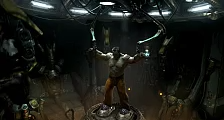 StarCraft 2: Wings of Liberty
StarCraft 2: Wings of Liberty
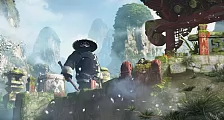 World of Warcraft: Mists of Pandaria
World of Warcraft: Mists of Pandaria


